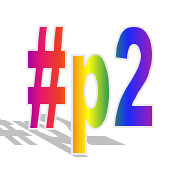 I wanted to expand on my remark in yesterday’s post about the gender ratio on #p2 staying “relatively well-balanced” with some statistics from the 24 hours ending at noon (Pacific time) today. While this is only one data point — and over a weekend, too — it’s roughly in line with the other measurements I’ve been makingover the last week.
I wanted to expand on my remark in yesterday’s post about the gender ratio on #p2 staying “relatively well-balanced” with some statistics from the 24 hours ending at noon (Pacific time) today. While this is only one data point — and over a weekend, too — it’s roughly in line with the other measurements I’ve been makingover the last week.
For about 80-90% of the people participating, it’s possible to able to infer the like gender of the tweeter based on self-descriptions (“mom” or “dad” for example), visual information, name, and so on. Of course there’s room for error here,* so don’t treat this as gospel; and my apologies to anybody I inadvertently misclassified. Still, it’s enough to get some useful information.
To start with, notice that there are at least three different discussions overlapping on the #p2 channel:
– “debating with conservatives“: tweets that also include #tcot.
– “progressives on Twitter“: tweets that also include #rebelleft and/or #topprog, but not #tcot.
– “#p2-only“: tweets to #p2 that don’t include any of those other hashtags.
With that as a framework, here are the numbers:
| tweets | women | men | % women | % tweets by women |
|
| #p2-only | 30 | 6 | 7 | 46% | 60% |
| progressives on Twitter |
59 | 6 | 10 | 38% | 15% |
| debating with conservatives |
99 | 3 | 17 | 15% | 9% |
| all posts to #p2 | 188 | 13 | 28 | 32% | 19% |
The much lower rate of participation by women in the debates with conservatives isn’t surprising at all. These frequently degenerate into unpleasantness and insults; research has consistently shown that women are less likely to participate in this kind of environment.**
And sadly, the much lower percentage of tweets by women also isn’t surprising.  In most mixed-gender online forums, the loudest participants are almost invariably guys. @kurtismarsh, for example, has contributed 33 tweets himself; and another 25 tweets respond to him, meaning that he’s responsible for over 30% of the traffic on the entire #p2 channel. In situations like this, the magic search query I discussed in Dealing with trolls on Twitter can be very useful for improving gender equity.
It’s pretty clear where the challenges are going forward. Most obviously, we want to encourage more women to participate; and that means being able to articulate why it’s worth their while. And we’ll need to keep the loud voices from drowning out everybody else. In addition, we’ll need to keep the heavily-male-dominated “debating” from overwhelming the rest of the #p2 channel; @martinschechter and @txvoodoo’s A modest proposal for #bipart could help a lot here.
Of course, gender’s far from the only dimension to keep in mind: for #p2 to reach its potential, we also need to be aware of race, age, orientation, language, and much more — as well as intersectional issues. Still, you gotta start somewhere. So hopefully keeping these considerations at the front of everybody’s minds will help #p2 be a diverse and inclusive environment.
jon
* and I computed these manually, another potential source of error. If anybody has any suggestions for an automated utility that’ll help here, I’m all ears — I’d love something like “Tweetstats for hashtags”.
** see Susan Herring’s Gender and Power in Online Communications for an overview and references. if you’re a blogger (or otherwise active online) and for some reason haven’t read this yet, you should. right now. seriously.
Leave a Reply